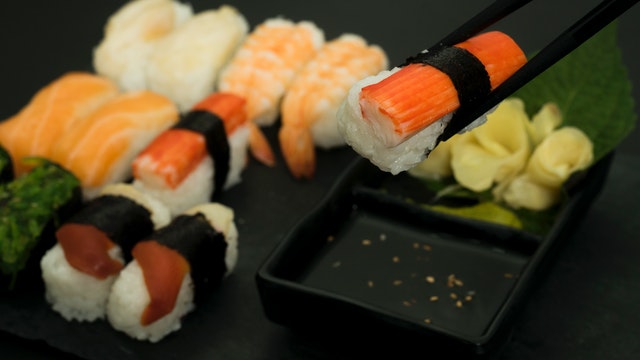
There’s no better place to learn Japanese than to immerse yourself in the culture and try some of the local delicacies. Sushi is a popular Japanese dish that is enjoyed not only in Japan but also around the world. Sushi has a strong tradition in Asia, and traditional Japanese cuisine differs significantly from sushi served in the United States, which brings us to the subject of etiquette. Whether you’ve been eating sushi for a long time or are new to it, learn the correct way to make it and familiarize the ingredients.
Ingredients
1.Nori
A nori sheet is a type of traditional sushi wrapper made from seaweed. They’ve been roasted and have the appearance of sheets of paper. Nori is a form of seaweed that can be found in sheets in Asian markets and specialized food stores like Whole Foods. While masters can roll sushi with full-size nori sheets, I recommend that newbies split the sheets in half and begin with that proportion. A smaller sheet of nori allows you to have more control over your sushi roll. Please bear in mind that nori can be easily stale; therefore, once opened, place in an airtight container or plastic bag in the refrigerator.
2.Sushi Rice
Sushi rice is one of the most significant elements in making sushi rolls. Sushi vinegar should be used to season the cooked short-grain rice. If you don’t have rice vinegar, go ahead and buy the pre-seasoned variety to save effort. Gently season with vinegar and salt to taste if you already have a bottle of rice vinegar or white vinegar on hand. Pour over the rice, mix with a spoon, and season with vinegar and salt to taste. Adjust the salt and sugar to taste. Remove the rice from the heat and place it in a bowl, covering it with a clean cloth.
You may also use pre-made sushi rice and season it with 2 tablespoons of seasoned rice vinegar per cup. Ensure that you choose seasoned rice vinegar. Regular rice vinegar lacks the sugar required for sushi rice to have a somewhat sweet taste. If you get plain rice vinegar instead, simply add 1 tablespoon of sugar to every half cup of vinegar. Use the rice right away, or store it in an airtight ziplock container in the refrigerator for up to three days.
3.Fillings
Sushi is traditionally filled with either (cooked or raw) fish or veggies. When it comes to fillings, tested-and-tried combinations like tuna and cucumber or salmon and cucumber are always a winner. Consider adding a crunchy ingredient such as pickles, tempura, or sesame seeds if you want to be creative with flavor, color, and texture. If you don’t eat raw fish, you can substitute other items. Experiment with different foods to see what works best for you.
You may start with simple fillings like sushi-grade tuna or salmon (or smoked salmon), cucumber, and avocado. The fresher the seafood for your sushi rolls, the better. Press down the fish meat with your index finger to see if it’s fresh. It should bounce back if it’s still fresh. There will be an indentation if it is not as fresh. If there was an indentation in the salmon, it’s still fine; it simply signifies it isn’t as fresh as it could have been.
Sushi Recipe TIps
* If you’re going to consume raw fish, be sure it’s sushi grade. You’ll become sick from parasites and bacterial contamination if the fish you use is not sushi grade. Handle your food with care, especially when it comes to raw ingredients, which should be kept refrigerated while not in use. Cross-contamination must be avoided! Allow only your utensils and the food you intend to eat it with to come into contact with your uncooked ingredients.
* Sushi recipes can be made vegetarian or vegan. There are a plethora of filler ingredients available online, but cucumbers, avocados, and carrots are excellent choices.
* Leave a small space between the rice to roll the sushi and top of the nori sheet properly and firmly. Put the ball of rice in the center of the nori sheet after wetting your hands. Roll the rice tightly after pressing it onto the sheet.
* Refrain from overstuffing. All newbies are inclined to stuff their sushi rolls with entirely too much filling and rice. So, what happens next? They roll up but then split open, squeezing stuff all over the place. Consider the concept that less is more – less is lovely — and use smaller portion sizes.
* Ensure your knife is somewhat damp while cutting the roll. Not only will this make cutting easier, but it will also guarantee a clean cut without destroying the roll. To moisten the knife tip, carefully dip it in water.
Here at Hanaya, we use the freshest and cleanest ingredients to make sure you have the best experience with the taste and the vibe of our restaurant. If you have yet to try our sushi rolls, we think you’re missing out on a tasty treat!
